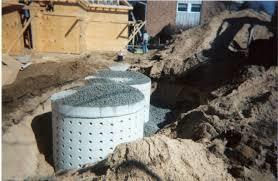I'm working on job right now that has a dry well comprised of 70-siv non-woven geotextile fabric filled with drain rock. A perforated PVC pipe sits in the middle of this gravel and disperses the water from several catch basins on the property. The perimeter french drain for a basement also drains into this dry-well.
Is it possible inject high pressure water into the rock and suck out the soil that will eventually build up? Would the a dry well comprised of a perforated tank be considered superior to this?
Is it possible inject high pressure water into the rock and suck out the soil that will eventually build up? Would the a dry well comprised of a perforated tank be considered superior to this?

